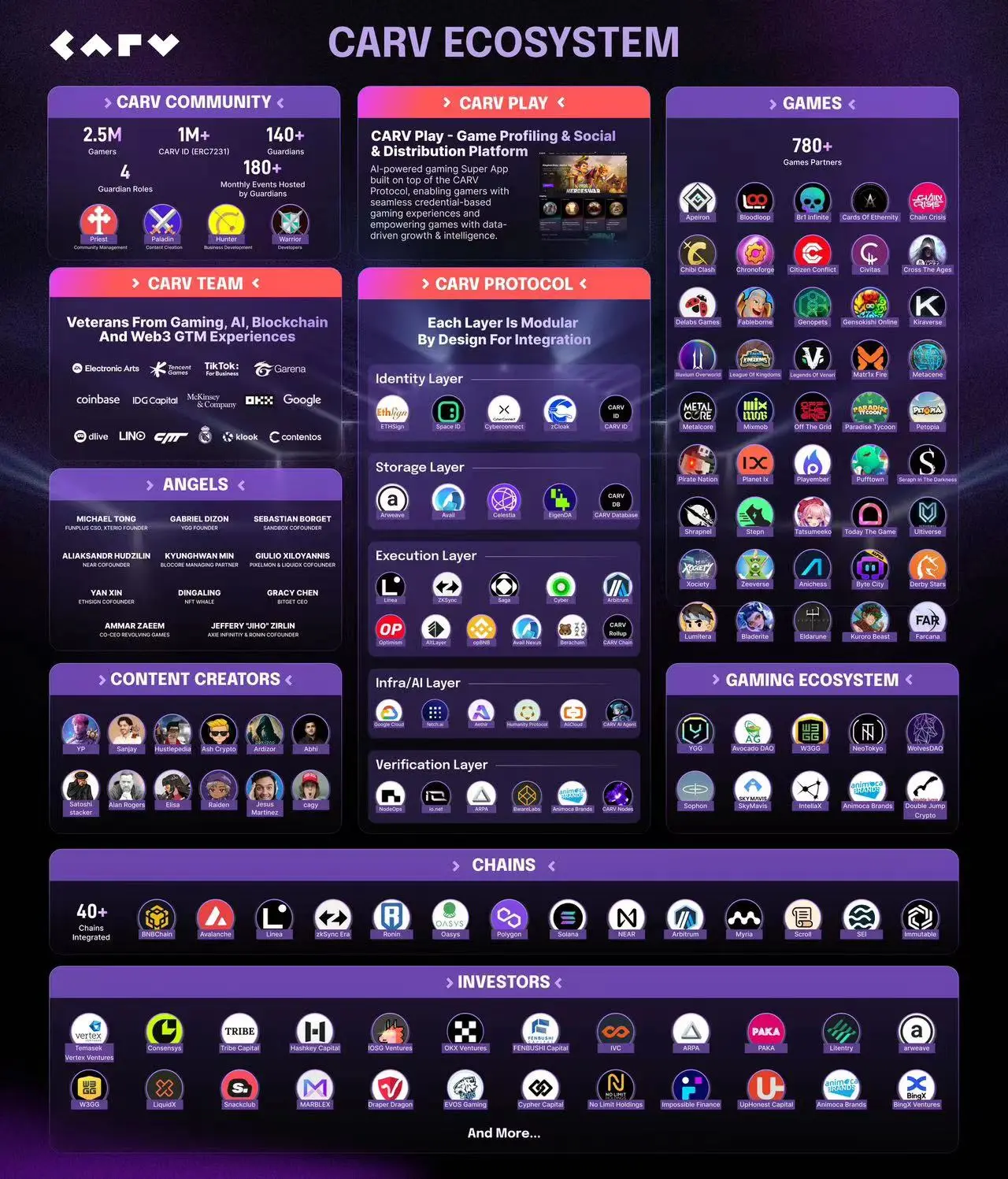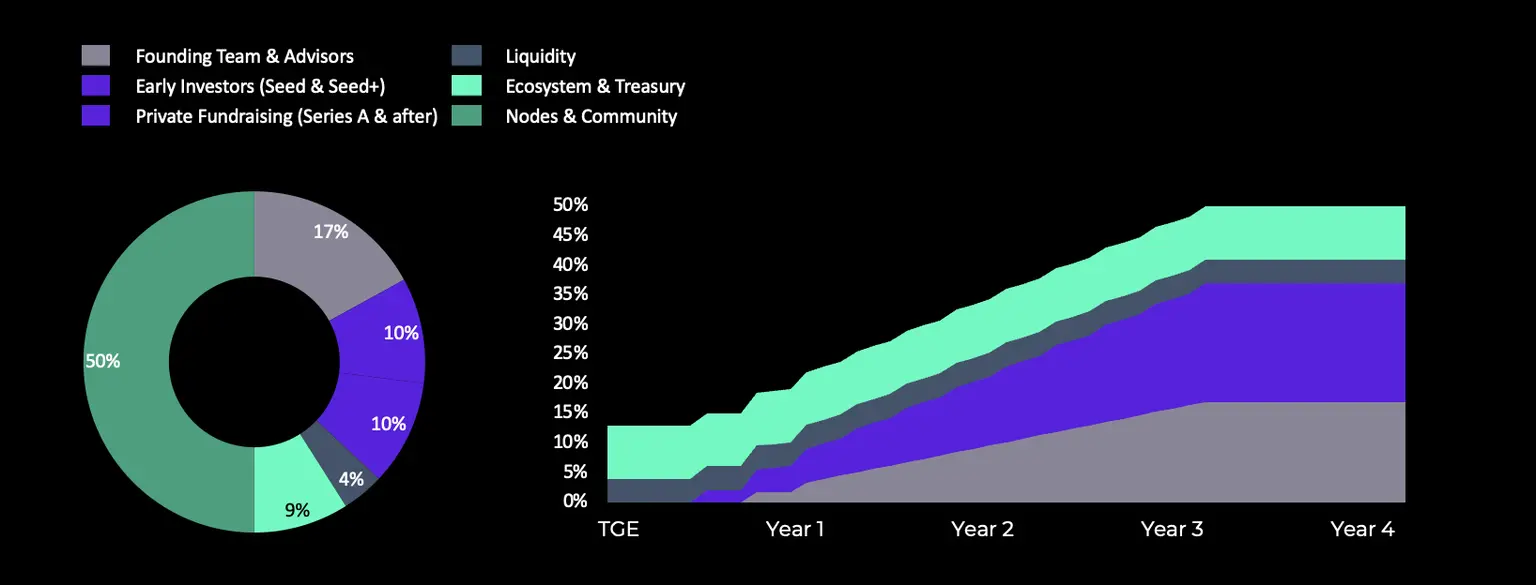Author: BlockBeats
The saying "If you are using a product for free, then you are the product" has become a maxim in the modern business society where Big Tech goes to great lengths to invade user privacy in order to profit from data. The true value and cost behind these free products lies in user data. Data is hailed as the "oil" of the new century, and as industries such as gaming and artificial intelligence continue to rapidly develop, data not only enhances user experience but also becomes the foundation of the entire ecosystem.
For ordinary users, it seems that they have never truly examined the importance of data to themselves, nor would they have thought that one day they could profit from the data they create. The protagonist of this article, CARV, aims to build a modular data layer for gaming, artificial intelligence, and Infinity, providing an unprecedented data management experience for project parties and users.
The CARV Protocol establishes a complete set of protocols that allow users to have full data sovereignty. Users can authorize, store, verify, confirm their own identity, player profiles, game data, and also earn data rewards through the protocol. At its current stage, it is selling CARV validation nodes, enriching and atomizing the validation layer through users owning nodes and proxy nodes.
Today marks the whitelist sale phase of CARV nodes, and the public sale of nodes will be held on June 5th, so it is hoped that this article will help readers decide whether to invest in CARV.
AI + Gaming, Users Can Earn Passive Income Using CARV
CARV builds an ecosystem consisting of the CARV Protocol and two products, CARV Play and CARV AI Agent, allowing users to bind their games, social media, and various other accounts to the blockchain. Users can unify their digital identities and showcase achievements, assets, and history in one place.
Furthermore, users can choose how their data is used. If they choose to join and share this data with brands, they can earn passive income when brands use their on-chain and off-chain data.
For example, CARV CBO Delio Paul once said in a speech that if a very popular Web3 FPS (first-person shooter game) wants to acquire users through CARV, they would pay CARV a fee to obtain user data, provided that the users agree to share this data.
If this game wants to find a user from Thailand who holds game tokens in their wallet and is a big whale in other ecosystems, and has also played hundreds of hours of FPS games, CARV can provide such user information. The key is that users who meet these criteria will profit from it, as a portion of the user acquisition fee paid to CARV by the game project will go directly to the users who provide the data.
Driven by this vision, CARV's core product development progress and its data performance are also impressive.
CARV AI Agent, CARA Bot, built on the TON ecosystem, is powered by a large GPT model and serves as CARV's encyclopedia and intelligent assistant, helping users answer questions about CARV. The next step will involve intelligent recommendations based on user's personalized data, D2E tasks, and exploration of advertisements.
Another product, CARV Play, is a cross-platform authentication system and the largest Web3 game distribution and social platform, with approximately 380 games currently available, accounting for 30% of the current Web3 games, including MARBLEX, Shrapnel, Off the Grid, Pixelmon, and Pixels.

In the previous quarter, its daily active wallet count exceeded 500,000, making it one of the top three ecosystems in terms of on-chain activity, alongside Linea, opBNB, zkSync, and Ronin, providing an enhanced gaming experience for 2.5 million players to share data, establish credentials, play games, and earn rewards.
Understanding CARV's Node Sales Model
The key component in all of this is CARV's validator nodes, which play a crucial role in maintaining the integrity of the protocol.
Currently, these nodes are mainly responsible for verifying the results of data processing and AI model training, which are performed in a trusted execution environment (TEE) to protect user data privacy. The results are recorded on the blockchain and accompanied by TEE proofs to ensure the security and privacy of the process, thereby fairly distributing the value of the data.
To prevent system manipulation and ensure fair distribution of data value, third-party verification of TEE proofs is required. This necessitates community participation in operating validation nodes to strengthen the protocol and increase its decentralization.
For users, the benefits of running CARV nodes mainly include:
Reward opportunities: A large portion of network rewards, 25% of CARV tokens, will be allocated to node validators.
Decentralization: Contributing to a truly decentralized data economy that respects user autonomy and privacy.
Influence: Having a voice in the CARV community to help shape the network's development and governance.
In order to allow global users to earn more income through the CARV network and enhance CARV's decentralization, CARV has decided to open lightweight node operations to users on June 5th. Participants can obtain the right to operate validation nodes through node sales, participate in the operation of the distributed data network, and earn CARV native tokens. The whitelist node sale will start at 10:00 (UTC) on June 3rd, and the public node sale will officially begin at 10:00 (UTC) on June 5th.
According to official documents, 25% of the total supply of CARV tokens will be provided to validator node operators, with emissions decreasing by 25% every 6 months from the TGE, meaning that 50% of the tokens can be unlocked in the first year.
The total supply of CARV tokens is 1 billion, to be unlocked over the four years following the TGE. The use cases for CARV tokens include gas payments and purchasing game assets, serving as ecosystem incentives for data owners, providers, and consumers to participate in ecosystem activities. In addition, CARV can be staked at a 1:1 ratio to convert to veCARV, which can be used to participate in community decision-making and ecosystem activities.

50% of the total supply of CARV tokens is evenly distributed to the community and nodes, which is a rare occurrence in the current climate of conflicting sentiments between VCs and retail investors. This demonstrates CARV's utmost sincerity in sharing benefits with users through the node sales model.
Previously, CARV partners such as Aethir, Sopon, and Xai have not only enhanced decentralization and gained a large amount of node support through this method, but also raised funds for project development. For ordinary investors, participating in node sales allows them to invest before the project starts, thereby gaining earlier entry opportunities and potential returns.
The release of node tokens is crucial in the first year, as it may be a bull market during that time, with a good coin price. If a bear market follows, the risk of a price drop increases as the accumulated token release increases and institutions and teams begin unlocking tokens. Therefore, the focus of the node release is on how many tokens can be mined within a year.
With a total token supply of 1 billion, the 25% reward for nodes is the most generous among similar projects, and releasing 12.5% of the total supply during the first year of a bull market reveals the scale of the project.
After the tokens are mined by the nodes, the operators do not immediately receive $CARV, but instead receive governance tokens veCARV, which can later be converted into $CARV for trading on CEX. Additionally, veCARV has a certain redemption period, but CARV's 150-day redemption period still holds a time advantage compared to other projects with a 180-day period.
Related reading: "Data Comparison: Aethir, Sopon, CARV, Which Node Sales Offer the Highest Returns?"
For node investors, it is also important to pay attention to the token unlocking time for the project party and investors. CARV's investors start unlocking six months after TGE, and the team starts unlocking nine months after TGE.
Furthermore, CARV has announced a token buyback plan, and node operators can choose from two buyback options.
The first option is a 100% buyback in $CARV, with the value equivalent to the node price in USDT at the time of purchase, linearly attributed within 30 days from the buyback date. The second option is an immediate 80% ETH buyback, with the value equivalent to the ETH price at the time of the node snapshot, and the ETH will be released immediately. Node license holders who meet the conditions must maintain a participation rate of 70% or higher and have not converted any veCARV rewards into $CARV, providing users and investors with greater flexibility and income security.
CARV's Future
For projects that obtain development funds through node sales, the most crucial test is the ability to sustain long-term operations. Currently, CARV is the project with the closest and most advantageous combination of AI and gaming, two popular sectors.
In terms of AI, CARV has announced partnerships with Aethir and Google Cloud. Aethir is a decentralized GPU network, and computing power is crucial for AI; while Google Cloud is a top-tier infrastructure provider, offering a variety of resources including CPU, network, resources, and CDN.
As an intermediary layer, CARV not only connects powerful infrastructure and GPU computing power, but also has its own AI agent and integrates top AI applications led by fetch.ai. For AI, combining data with infrastructure and GPU will create greater potential.
Another pillar of CARV's business is in the gaming sector. As mentioned earlier, CARV's users can actively choose to provide their data to earn passive income, and for B-side clients, CARV is also working hard to accumulate more comprehensive data to serve the gaming industry. CARV's presence enables a win-win situation for both games and gamers.
Through an interview with CARV founder Victor, we learned that CARV's current focus is to better support node development, including making it easier for users to run nodes and improving the overall operation and purchasing experience. Next, CARV plans to expand the application of the node network as soon as possible, including the validation of the data layer and the implementation of oracles.
In addition, CARV's larger vision is to establish its own validation network and processing system, ultimately realizing its own data layer, including data availability (DA) and storage.
On May 31st, Animoca Brands announced its strategic investment in CARV and becoming a node operator, injecting more confidence into CARV's future development. According to the roadmap, CARV will strongly support and incentivize node deployment and development in the coming quarters. Therefore, for users, choosing to participate in CARV's node sales at this time will allow them to participate in ecosystem development with the lowest threshold and gain both active and passive income.
免责声明:本文章仅代表作者个人观点,不代表本平台的立场和观点。本文章仅供信息分享,不构成对任何人的任何投资建议。用户与作者之间的任何争议,与本平台无关。如网页中刊载的文章或图片涉及侵权,请提供相关的权利证明和身份证明发送邮件到support@aicoin.com,本平台相关工作人员将会进行核查。




